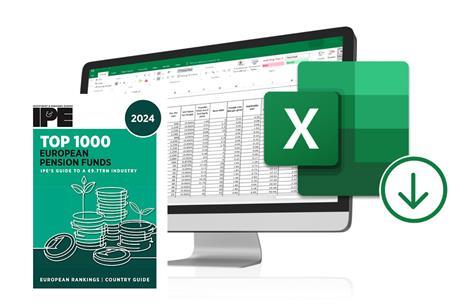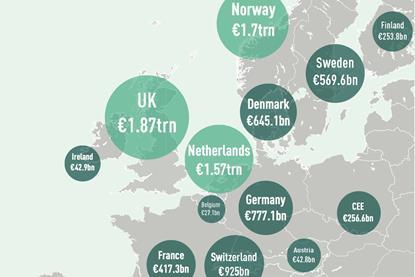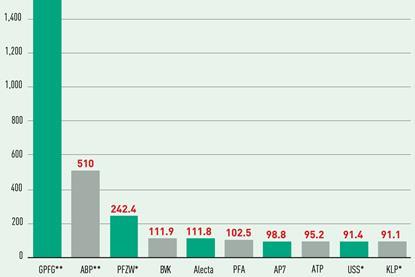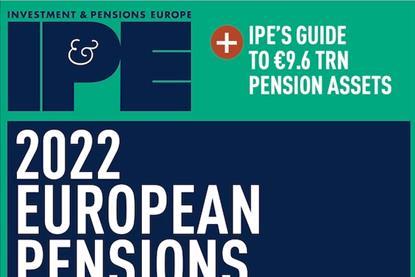Top 1000 European Pension Funds 2024
Comprehensive Analysis of Europe’s €9.7 Trillion Pensions Market
Discover IPE’s extensive study on the European pensions landscape with the Top 1000 European Pension Funds 2024. This detailed report offers an in-depth ranking of the leading pension institutions by assets and provides a comprehensive asset allocation breakdown for the top funds.
Key Benefits of Accessing the Report:
- In-depth ranking of over 1000 pension institutions by assets
- Country-by-country analysis across Europe’s pensions market
- Detailed asset allocation data for the top 100 pension funds
- Comprehensive pension regulation report covering key European markets
- A downloadable Excel file containing rankings based on AUM and asset allocation breakdown
Enhance your understanding of Europe’s pensions market and gain insights into the €9.7 trillion industry.
Top 1000 Pension Funds 2024: Pensions back at a sweet spot
Assets for the leading 1000 European pension funds grew by 8.7% year-on-year, reversing last year’s loss of 6.8%. This brings total assets back up to above their previous high water mark of €9.7trn in 2022’s research exercise. This year’s overall net gain in assets of €775bn is the largest since 2021’s increase of €810bn.
Support data-driven decision-making. Access the Top 1000 European Pensions Dataset 2024
Download the complete 2024 survey dataset providing detailed information on 1000 European Pension Funds. Whether you are a pension fund wanting to know how you measure up against your peers, an asset manager building a business, or a service provider in this multi-trillion Euro sector - our data provides the most authoritative picture of pension assets across the continent.
More Top 1000 Pension Funds 2024
Top 1000 Pension Funds 2024: Pensions back at a sweet spot
Assets for the leading 1000 European pension funds grew by 8.7% year-on-year, reversing last year’s loss of 6.8%. This brings total assets back up to above their previous high water mark of €9.7trn in 2022’s research exercise. This year’s overall net gain in assets of €775bn is the largest since 2021’s increase of €810bn.
Top 1000 Pension Funds 2024: Data
Skewed distribution of European pension fund assets
Top 10 European pension funds raise equity and bond exposure
Pension funds in most European countries recorded strong returns of between 6% and 9%, according to preliminary figures published this summer by the OECD.
Austria: Waiting for politics to get serious about pensions
With elections looming, Austrian politicians are not making pensions a priority
Belgium: Funding decision awaits new government
The coalition is likely to push through more radical pension reforms
Denmark: Pensions finally free from cumbersome banking regulations
Schemes have been liberated from onerous rules that were irrelevant to them
Finland: Government threatens indecisive social partners
The tripartite working group tasked with reforming the country’s pension system has not yet reached consensus on reforms
France: Macron’s reforms look secure
President Macron’s pension reforms may have their detractors, but the hung parliament is not expected to roll back any of them significantly
Germany: Politicians look to bolster pensions ahead of elections
Draft bills prepared by the government to change public, private and occupational pensions are bound for parliamentary debate
Iceland: New law opens up rental markets
Reforms will lead to fundamental changes in Icelandic pensions
Ireland: Auto-enrolment slips to vaguer deadline
With a general election looming, there are concerns that workplace pensions will not be a priority
Italy: Policymakers focus on first pillar
Despite recent growth, second-pillar pensions have never been a priority for the Italian government
Netherlands: First funds prepare for DC switch
Despite pre-election threats, the transition is not expected to be rolled back by the new government
Norway: New buffer fund rules to boost returns
Providers of private guaranteed pension products are now allowed to take more risk in an effort to improve performancean
Portugal: Sticking to the pension promise
The country’s new government has vowed to increase retirement payments
Spain: Sweeping pension reforms fail to get off the ground
The country’s unstable political environment means pensions are not a priority
Sweden: Alecta continues to hit the headlines
Swedish policymakers are kept busy as the prospect of a merger of the AP funds is again under the spotlight
Switzerland: Workplace pension reform faces referendum test
The country is introducing regulations on greenwashing and fund investments, while debating how to fund the first and second-pillar pension systems
Previous Top 1000 Pension Funds
Top 1000 Pension Funds 2023: Europe’s pensions absorb a €646bn loss
Last year saw a net reduction in the asset stock of European pension investment retirement pools of 6.77% over the previous year, according to IPE’s annual study of the leading 1,000 pension funds across the continent, marking a sea change for pensions.
Top 1000 Pension Funds 2022: Pension assets increase reflects 2021’s markets
The assets of the leading 1000 European pension funds increased by well over €600bn in our latest survey – a large portion of which can be attributed to strong investment returns on the back of a sustained post-COVID rebound over the course of 2021. Developed market equities returned over 30% in euro terms in 2021, compared with losses of around 4.7% in global aggregate bonds.
Top 1000 Pension Funds 2021: Powering on ahead
With a gross headline increase in pension assets of over €800bn – or 9.8% – Europe’s pension fund asset pools can be said to have powered through the COVID-19 crisis, riding the market highs to bank a solid recovery.













